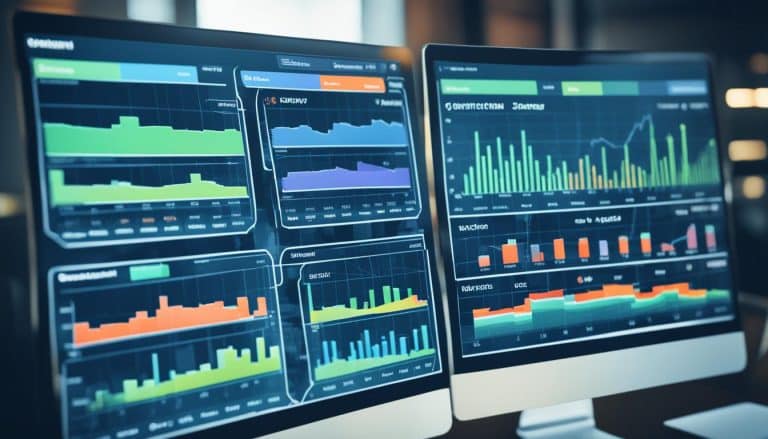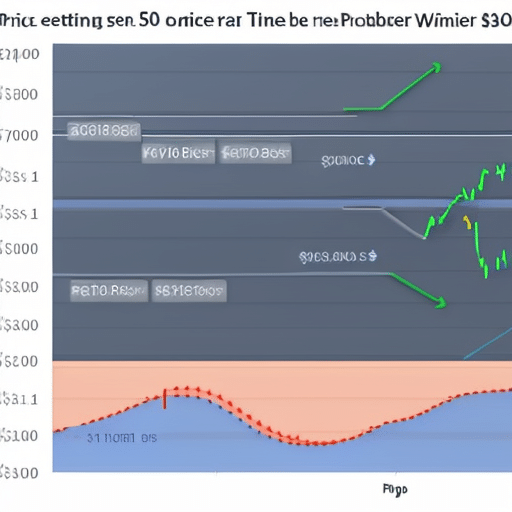Xrp Technical Analysis
XRP is a digital asset created by Ripple company to facilitate global payments. It is currently the third largest cryptocurrency by market capitalization and has seen considerable price appreciation over the past year. Technical analysis of XRP can provide valuable insights into its current and future price movements, allowing traders and investors to make informed decisions regarding their positions in this asset class. In this article, we will examine some of the fundamental principles behind XRP technical analysis, including historical price data, technical indicators, forecasting tools, and more. We will also discuss automated trading systems, arbitrage strategies, social trading platforms, and leveraged trading opportunities available for XRP holders.
Analyzing Historical Price Data
Historical price data for XRP reveals that in 2017 the cryptocurrency experienced a notable high of $3.84, representing an increase of over 3500% from its opening price at the start of the year. This dramatic surge in value was largely attributed to speculation and rumors regarding potential partnerships, as well as allegations of possible price manipulation and liquidity issues. The extraordinary performance of XRP during this period has been widely debated by many industry experts, with some arguing that these factors had no bearing on the asset’s valuation while others cite them as primary drivers behind such rapid growth. With this in mind, it is important to conduct a fundamental analysis of XRP to understand its true potential going forward into the future.
Fundamental Analysis of XRP
Fundamental analysis of XRP is a comprehensive examination of the cryptocurrency’s underlying fundamentals, such as its market capitalization, transaction volume, and network activity. Market capitalization provides investors with an insight into the size of the asset and its relative importance in comparison to other cryptocurrencies. Transaction volume reveals how much trading activity is taking place on different exchanges that offer XRP. Lastly, network activity measures the number of transactions that have taken place on the Ripple network over a given period of time. All three metrics can be used to evaluate whether or not XRP is a good investment opportunity.
Market Capitalization
Ripple (XRP) is currently the third largest cryptocurrency by market capitalization, behind Bitcoin and Ethereum. Market capitalization is a measure of the current total market value of a certain crypto asset, based on its supply and demand, macroeconomic factors, and other related economic data. In the case of Ripple (XRP), its market capitalization has grown considerably since it was first created in 2012. This growth can be attributed to increased investor confidence in the project as well as wider adoption by financial institutions across the world.
With increasing acceptance of Ripple’s underlying technology among various businesses and organizations, transaction volumes have also grown significantly over time. This has further contributed to the surge in Ripple’s market capitalization which continues to rise steadily with each passing day. As more investors become aware of this digital asset’s potential for future gains, XRP may continue to grow in terms of both value and market share in the coming years.
Transaction Volume
The growing adoption of Ripple’s technology has resulted in a surge in transaction volumes, which has been a key factor driving the cryptocurrency’s market capitalization. Transaction volume is an important measure of liquidity and activity on a network; it can also indicate speculator interest or momentum for day trading and margin trading.
Key aspects to consider when analyzing transaction volume include:
- The average daily transactions per day
- The overall trend of transactions over time
- The ratio between buy/sell orders
- Volume spikes at certain times during the session.
These metrics all contribute to understanding the current state of the XRP market and how it might move in the future, as well as identifying potential opportunities for traders looking to capitalize on short-term movements. With this information, investors can gain insights into network activity and make informed decisions about their investments accordingly.
Network Activity
Network activity is an important indicator of the current state of the cryptocurrency market as it provides insight into liquidity and trading interest. Network scalability, which refers to the ability of a network to grow its capacity over time, is a key factor in assessing network activity. This also involves evaluating consensus protocols such as Proof-of-Work (PoW) and Proof-of-Stake (PoS). These protocols are used by cryptocurrencies to validate transactions and achieve consensus across all nodes in the network. As such, these protocols can provide valuable insights into transaction speeds and overall network performance. Additionally, they may also indicate how secure a particular cryptocurrency’s blockchain is against malicious attacks or other forms of disruption.
The analysis of network activity can be used to evaluate trends in trading interest and liquidity for any given cryptocurrency. It can therefore provide useful information for traders trying to identify potential buying or selling opportunities that could result from changes in market sentiment towards specific assets. By examining how quickly transactions are processed on a given blockchain and analyzing data related to fees paid for transactions, investors can gain greater insight into potential trading signals that could indicate future price movements. In conclusion, understanding network activity is essential for successful technical analysis when it comes to cryptocurrencies like XRP. The next step will be exploring technical indicators which offer further clues about price action.
Technical Indicators
An analysis of XRP’s price movement can be made with a number of technical indicators. The Relative Strength Index (RSI), Moving Average Convergence Divergence (MACD) and Bollinger Bands are three of the most commonly used indicators in technical analysis. These indicators provide insight into the strength or weakness of a currency, as well as possible areas where prices may begin to move in either direction. By using these tools, traders can gain an understanding of current market trends and make informed decisions about when to enter or exit positions.
Relative Strength Index (RSI)
Exploring the Relative Strength Index (RSI) can provide insight into predicting price movements of XRP. The RSI measures the magnitude and speed of changes in price movements over a given period, allowing traders to identify potential buying and selling opportunities. This technical indicator is based on fundamental drivers such as supply and demand, sentiment analysis, momentum, and volatility. By comparing the relative strength or weakness of an asset over a specific period of time, traders can determine whether it is overbought or oversold compared to its historical range. Using this information, investors can enter into buy-and-sell positions at more favourable prices with the goal of making greater returns on their investments. Additionally, traders may also use RSI to confirm trends derived from other indicators such as Moving Average Convergence Divergence (MACD). With this technical tool available at their disposal, investors may be able to better anticipate market peaks and troughs for XRP trading purposes.
Moving Average Convergence Divergence (MACD)
Moving Average Convergence Divergence (MACD) is a widely utilized technical indicator used to identify momentum and trend reversals. The MACD is calculated by subtracting the 26-period exponential moving average from 12-period EMA on a given security’s price chart. This results in a line that oscillates above and below a zero level, indicating the strength of the market trend. The MACD can be used as an excellent tool for traders interested in Ripple mining or trading psychology, as it helps them to predict potential market direction changes.
Moreover, when combined with other indicators like Bollinger Bands, the MACD can help traders identify buy/sell signals more accurately and gain insight into future price movements. By factoring in volatility levels along with particular trading styles, this indicator can provide invaluable insights for crypto investors seeking to maximize profits while minimizing risks associated with cryptocurrency investments. As such, transitioning into discussing about Bollinger Bands should provide further valuable input for XRP technical analysis.
Bollinger Bands
Charting a security’s price action with Bollinger Bands provides an insightful glimpse into potential market directions. Developed by John Bollinger in the 1980s, these bands are based on a 20-day simple moving average of closing prices, and upper and lower bands that are two standard deviations away from the 20-day SMA. This type of technical analysis helps to provide a view of the current market volatility compared to historical levels as well as identify potential trading opportunities. Traders can use scalping techniques such as buying when the price touches one of the bands or selling when it touches both bands. Furthermore, this approach offers traders insight into their own psychology by showing them where they might be too optimistic or pessimistic in their expectation about future prices movements. This knowledge can ultimately help to guide more profitable trades for investors. Thus, Bollinger Bands offer useful information that investors can use to make informed decisions about their investments and gain an understanding of how XRP is likely to move in future markets.
XRP Price Forecasting
Analyzing XRP price forecasting requires an understanding of the various factors influencing its market performance. Fundamental drivers such as macroeconomic conditions, geopolitical events, and regulatory developments all affect pricing trends in the cryptocurrency asset class. Risk analysis is also key to understanding how XRP’s volatility behaves in different market scenarios. Additionally, technical indicators can be used to identify support and resistance levels that may signal potential future price changes.
These fundamental drivers, risk analysis, and technical indicators must be taken into account when attempting to forecast XRP’s future price movements. Moreover, it is essential to understand the broader cryptocurrency market in order to assess any major shifts that may have a significant impact on prices. By analyzing both individual assets and the overall crypto landscape, traders are better equipped to make informed investments decisions regarding XRP trading activities.
Analyzing the Cryptocurrency Market
Surveying the cryptocurrency market can provide a comprehensive picture of both individual asset performance and macroeconomic trends in the digital currency space. One key factor to consider when analyzing the crypto market is pump and dump schemes, which refer to activities wherein investors manipulate prices by artificially inflating them followed by selling off their holdings once prices have reached an optimal level. Dark pools are another important concept to be aware of as they allow investors to make large transactions away from traditional exchanges, thus potentially creating instability in prices. Furthermore, certain dark pool operators may also engage in predatory practices such as front-running or insider trading, which can further distort asset values. As such, it is critical for investors to understand the potential risks associated with this type of investing before making any decisions. A risk management strategy should be implemented in order to mitigate these risks and ensure that investments remain profitable over time.
Risk Management
Implementing a risk management strategy is essential for investors in the cryptocurrency market in order to mitigate potential risks associated with investing and ensure profitability over time. Risk assessment is vital to recognize the level of volatility in the cryptocurrency markets, as well as identify any external factors that may impact prices. Portfolio diversification can also be beneficial to spread out investments across different assets, reducing exposure to any single coin or token. This helps reduce overall losses when prices decrease, and also provides an opportunity for increased gains if certain coins outperform others. By employing risk management techniques such as these, investors can promote more successful trading strategies and longer-term profitability. In order to maximize success, it is important for traders to understand how cryptocurrency trading strategies can be employed in their own portfolios.
Cryptocurrency Trading Strategies
Developing an informed understanding of cryptocurrency trading strategies is essential for investors in the cryptocurrency market to maximize profitability and reduce their potential risk. Scalping strategies are a popular choice among many traders, as they involve frequent buying and selling with profits taken at very small margins. This requires an immense amount of discipline and focus, however, as any mistake can quickly erode the profits gained from scalping. Stop loss orders are also more commonly used by newer or less experienced traders, as they provide a measure of protection against losses if prices move against them. By setting predetermined points at which trades will be closed out automatically, these stop loss orders can help limit the damage that can be caused by market volatility while allowing traders to remain in control of their investments. Ultimately, understanding how different strategies work and what risks they entail is key to getting the most out of XRP trading. This knowledge is then complemented by careful research into various trading platforms and exchanges available for XRP transactions.
Trading Platforms and Exchanges
With over 300 cryptocurrency exchanges globally, there is an abundance of options for XRP trading. According to a recent report, the top three exchanges account for nearly 70% of all global XRP trading volume. Understanding the nuances of each platform and mastering a few key concepts can help traders make informed decisions when it comes to choosing an exchange and making trades. One important concept in trading psychology is understanding order types, such as market orders, limit orders, stop-loss orders and more. By having knowledge of these different order types, traders can gain greater control over their trades and manage risk effectively. Additionally, understanding the features that each exchange offers provides traders with a better overview of what they’re looking for in an exchange and enables them to make better decisions when it comes to choosing one that meets their needs. As taxation on cryptocurrencies becomes increasingly relevant, it is important for traders to understand how their trades might be taxed by different countries or regions.
Taxation of Cryptocurrency
Following on from the discussion of trading platforms and exchanges for XRP, taxation of cryptocurrency is another important consideration. Most countries have yet to issue formal guidance on how to treat cryptocurrency when it comes to taxation. This leaves many people uncertain as to what their obligations are, particularly in light of the potential for tax evasion risks that come with digital currencies. Legal implications can arise if taxes are not paid correctly or on time, so it is crucial that taxpayers understand what they need to do when filing their returns.
The lack of clarity around taxation has also led some investors to take a more risk-averse approach when looking at cryptocurrency investments due to the potential legal liabilities associated with non-compliance. The ability of law enforcement agencies to trace transactions made via blockchain technology means there is an increased threat of prosecution for individuals who attempt to evade taxes. As such, understanding the applicable rules and regulations in any given jurisdiction should be a priority for anyone dealing with cryptocurrencies such as XRP in order to ensure compliance and avoid any unwanted legal issues down the line. With this understanding firmly established, we now turn our attention towards security considerations related to investing in XRP.
Security Considerations
Investing in XRP requires an understanding of security considerations to ensure a safe experience. Data security must be taken into account when storing XRP, as any compromise can lead to financial losses. Major risks that should be avoided include unauthorized access, third-party manipulation, and malware attacks on digital wallets. To protect against these threats, investors should use secure hardware wallets or cold storage options that are not connected to the internet. Additionally, wallet security must also be addressed in order to keep funds secure from hacking attempts. This includes using strong passwords for accounts and enabling two-factor authentication when possible. By following these best practices, investors can feel confident their XRP holdings will remain secure. In order to further minimize risk, traders may consider turning to automated trading systems which can help manage positions without human intervention.
Automated Trading Systems
The potential of automated trading systems to take control of positions without human intervention can be compared to a chess master playing against an opponent. Automated trading systems use algorithms and pre-programmed instructions to scan the markets for opportunities and execute trades automatically. This is especially useful for traders who wish to take advantage of arbitrage opportunities quickly, or those who cannot monitor their positions around the clock. As cryptocurrency regulations become increasingly complex, automated trading systems offer an efficient way for traders to stay on top of all market developments while ensuring compliance with applicable laws. Additionally, as blockchain technology continues to develop in terms of scalability, automated trading systems can help reduce transaction times and fees associated with manual interventions. Ultimately, these technologies provide users with greater flexibility and freedom when it comes to managing their portfolios. With this in mind, it is clear that automated trading systems carry great potential for traders looking to maximize their returns in this rapidly evolving industry. Taking into consideration these advantages, it is no surprise that many investors are turning towards such technologies as a viable alternative when it comes to making informed decisions regarding their investments. Moving forward, it will be interesting to observe how the development of algorithmic solutions continues shaping the landscape of cryptocurrency markets going forward into the future.
Arbitrage Trading
Arbitrage trading offers investors the opportunity to capitalize on discrepancies in pricing across markets, thereby potentially generating profits from these imbalances. This type of trading is particularly attractive to cryptocurrency investors, as arbitrage opportunities are often available due to the volatility of the market and different exchanges offering varying prices for the same asset. Understanding trading psychology is key for successful arbitrage traders who must be able to identify profitable opportunities quickly and act upon them before they disappear. Additionally, it is important to factor in costs associated with trading such as commissions and fees that can eat away at potential profits and influence decisions about when or if a trade should be opened or closed. As such, understanding both the technical aspects of cryptocurrency investing and also trading psychology can give arbitrage traders an edge in this highly competitive market. Transitioning into social trading, which involves copying or following other successful traders’ strategies, provides another avenue for cryptocurrency investors looking for profit-making opportunities.
Social Trading
Social trading seeks to facilitate the financial gains of investors by allowing them to benefit from the strategies of successful traders. This type of trading is based on analyzing social media and sentiment analysis in order to make informed decisions about when and how to invest. Through social trading, investors can observe and copy the actions taken by other traders, as well as view their performance over time. This provides a great opportunity for novice investors who may not have the necessary experience or knowledge to make effective investments on their own. Additionally, it allows experienced traders an additional avenue for diversifying their portfolio while simultaneously helping less experienced traders increase their potential profits. By leveraging the wisdom of more experienced investors, social trading presents a unique opportunity for both novice and veteran traders alike to optimize returns in XRP markets. Leveraged trading is another way for investors to maximize potential returns with reduced risk.
Leveraged Trading
Leveraged trading enables investors to potentially generate significantly higher returns with lower levels of risk. This is achieved through the use of financial leverage, which essentially allows traders to open positions that are larger than the capital they have on hand. Leverage can be used by traders who believe prices will rise or fall and can offer tremendous gains if the predictions turn out to be correct. Trading platforms often allow users to choose a leverage ratio depending on their individual goals and preferences. For example, some may prefer a 1:1 ratio which offers minimal risk in order to protect long-term investments while others may opt for higher ratios such as 10:1 in order to increase potential profits from short-term trades.
In the XRP market, leveraged trading has become increasingly popular among experienced investors who understand the risks involved and are willing to take them in order to gain extra profits from their investments. As with other types of trading, it is important for investors to do their due diligence when choosing a platform for leveraged trading and ensure that it meets their individual needs before committing funds. With careful research and smart decision making, leveraged trading can be an effective way for XRP traders to maximize profits while reducing overall risk exposure.





 Bitcoin
Bitcoin  Ethereum
Ethereum  XRP
XRP  Tether
Tether  Solana
Solana  USDC
USDC  Dogecoin
Dogecoin  TRON
TRON  Lido Staked Ether
Lido Staked Ether  Cardano
Cardano  Hyperliquid
Hyperliquid  Stellar
Stellar  Wrapped Bitcoin
Wrapped Bitcoin  Sui
Sui  Wrapped stETH
Wrapped stETH  Chainlink
Chainlink  Hedera
Hedera  Bitcoin Cash
Bitcoin Cash  Avalanche
Avalanche  LEO Token
LEO Token  Wrapped eETH
Wrapped eETH  Shiba Inu
Shiba Inu  WETH
WETH  Toncoin
Toncoin  Litecoin
Litecoin  USDS
USDS  WhiteBIT Coin
WhiteBIT Coin  Monero
Monero  Binance Bridged USDT (BNB Smart Chain)
Binance Bridged USDT (BNB Smart Chain)  Polkadot
Polkadot  Coinbase Wrapped BTC
Coinbase Wrapped BTC  Ethena USDe
Ethena USDe  Pepe
Pepe  Bitget Token
Bitget Token  Uniswap
Uniswap  Aave
Aave  Bittensor
Bittensor  Dai
Dai  Pi Network
Pi Network  Aptos
Aptos  Cronos
Cronos  NEAR Protocol
NEAR Protocol  Ethena Staked USDe
Ethena Staked USDe  Internet Computer
Internet Computer  OKB
OKB  Ondo
Ondo  Jito Staked SOL
Jito Staked SOL  Ethereum Classic
Ethereum Classic  BlackRock USD Institutional Digital Liquidity Fund
BlackRock USD Institutional Digital Liquidity Fund